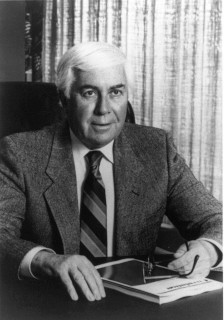Jeremy Swan
Jeremy Swan was a prominent physician and cardiologist known for his significant contributions to the field of cardiology. He is best known for co-inventing the Swan-Ganz catheter, a device that revolutionized the monitoring of hemodynamics in critically ill patients.
Early Life and Education[edit | edit source]
Jeremy Swan was born in Sligo, Ireland. He pursued his medical education at the University of London, where he earned his medical degree. Following his graduation, Swan completed his residency and fellowship in cardiology, which laid the foundation for his future contributions to the field.
Career[edit | edit source]
Swan began his career as a cardiologist at the Cedars-Sinai Medical Center in Los Angeles, California. It was here that he collaborated with William Ganz, a fellow cardiologist, to develop the Swan-Ganz catheter. This device allowed for the direct measurement of pulmonary artery pressure, providing critical information for the management of patients with complex cardiac conditions.
Swan-Ganz Catheter[edit | edit source]
The Swan-Ganz catheter is a type of pulmonary artery catheter used to measure pressures in the right side of the heart and the pulmonary artery. This innovation has been instrumental in the management of patients with heart failure, shock, and other critical conditions. The catheter is inserted through a large vein and threaded into the right side of the heart and into the pulmonary artery. It provides valuable data on cardiac output, pulmonary capillary wedge pressure, and other hemodynamic parameters.
Contributions to Cardiology[edit | edit source]
Jeremy Swan's work extended beyond the invention of the Swan-Ganz catheter. He published numerous research papers and articles on various aspects of cardiology, including cardiac physiology, hemodynamic monitoring, and the management of acute myocardial infarction. His contributions have had a lasting impact on the field and have improved the care of countless patients with cardiac conditions.
Awards and Recognition[edit | edit source]
Throughout his career, Swan received numerous awards and honors for his contributions to medicine. He was a member of several prestigious medical societies, including the American College of Cardiology and the American Heart Association. His work has been recognized globally, and he is considered a pioneer in the field of cardiology.
Personal Life[edit | edit source]
Jeremy Swan was married and had children. He was known for his dedication to his family and his passion for medicine. In his later years, he continued to be involved in medical education and mentoring young physicians.
Legacy[edit | edit source]
Jeremy Swan's legacy lives on through the countless lives saved and improved by his innovations in cardiology. The Swan-Ganz catheter remains a critical tool in the management of critically ill patients, and his contributions to the field continue to influence modern cardiology practices.
See Also[edit | edit source]
- Cardiology
- Pulmonary artery catheter
- Hemodynamics
- Cedars-Sinai Medical Center
- American College of Cardiology
- American Heart Association
References[edit | edit source]
External Links[edit | edit source]
Search WikiMD
Ad.Tired of being Overweight? Try W8MD's physician weight loss program.
Semaglutide (Ozempic / Wegovy and Tirzepatide (Mounjaro / Zepbound) available.
Advertise on WikiMD
|
WikiMD's Wellness Encyclopedia |
| Let Food Be Thy Medicine Medicine Thy Food - Hippocrates |
Translate this page: - East Asian
中文,
日本,
한국어,
South Asian
हिन्दी,
தமிழ்,
తెలుగు,
Urdu,
ಕನ್ನಡ,
Southeast Asian
Indonesian,
Vietnamese,
Thai,
မြန်မာဘာသာ,
বাংলা
European
español,
Deutsch,
français,
Greek,
português do Brasil,
polski,
română,
русский,
Nederlands,
norsk,
svenska,
suomi,
Italian
Middle Eastern & African
عربى,
Turkish,
Persian,
Hebrew,
Afrikaans,
isiZulu,
Kiswahili,
Other
Bulgarian,
Hungarian,
Czech,
Swedish,
മലയാളം,
मराठी,
ਪੰਜਾਬੀ,
ગુજરાતી,
Portuguese,
Ukrainian
Medical Disclaimer: WikiMD is not a substitute for professional medical advice. The information on WikiMD is provided as an information resource only, may be incorrect, outdated or misleading, and is not to be used or relied on for any diagnostic or treatment purposes. Please consult your health care provider before making any healthcare decisions or for guidance about a specific medical condition. WikiMD expressly disclaims responsibility, and shall have no liability, for any damages, loss, injury, or liability whatsoever suffered as a result of your reliance on the information contained in this site. By visiting this site you agree to the foregoing terms and conditions, which may from time to time be changed or supplemented by WikiMD. If you do not agree to the foregoing terms and conditions, you should not enter or use this site. See full disclaimer.
Credits:Most images are courtesy of Wikimedia commons, and templates, categories Wikipedia, licensed under CC BY SA or similar.
Contributors: Prab R. Tumpati, MD

